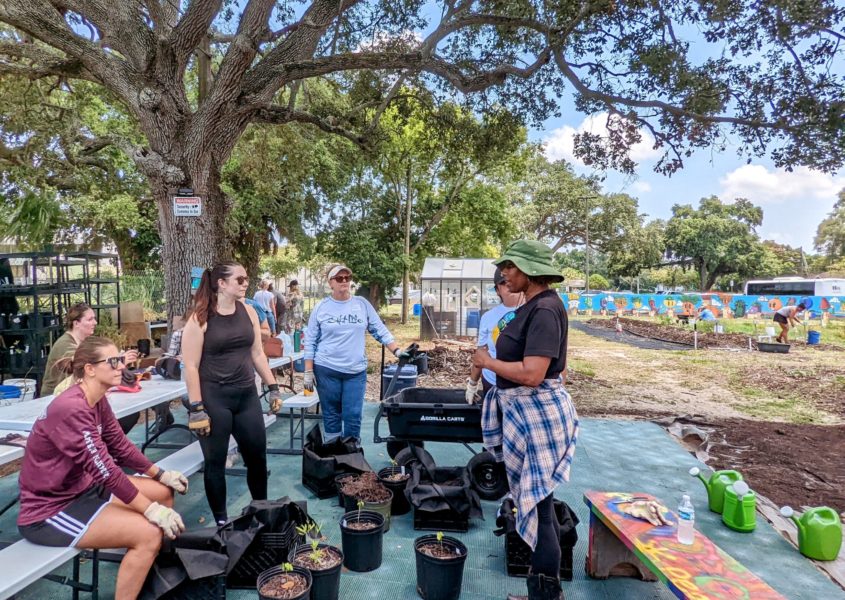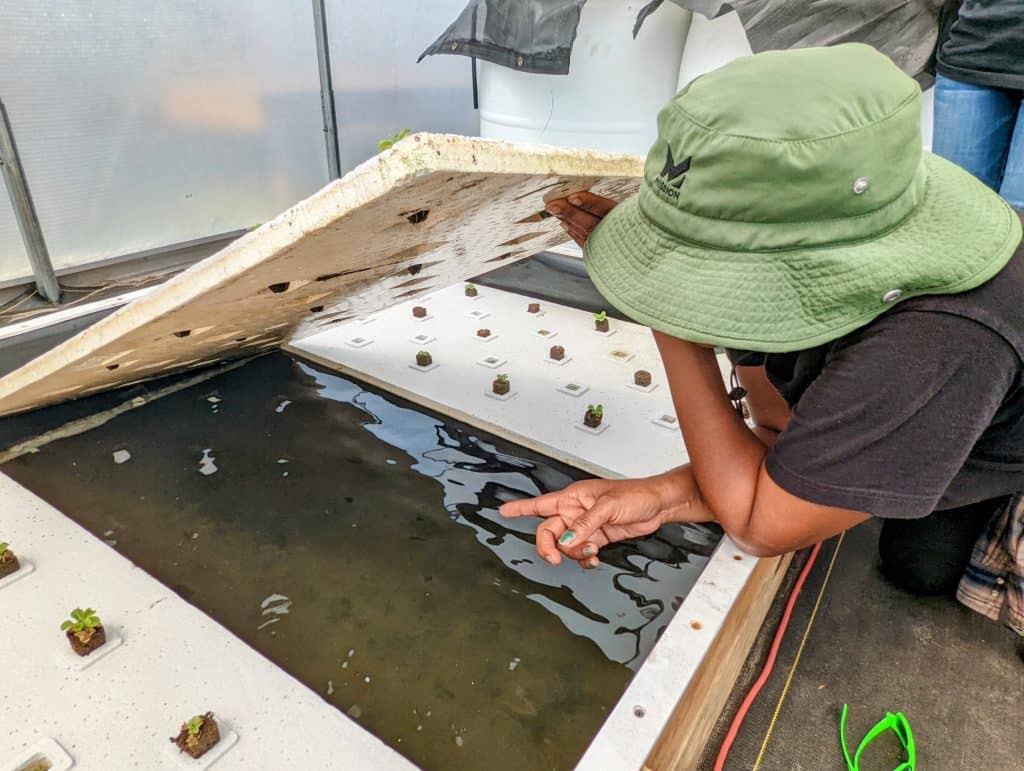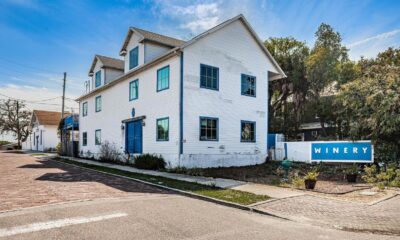Impact
As the St. Pete Youth Farm grows, so does its impact

It is a sweltering late June afternoon in South St. Petersburg, but Carla Bristol seems unfazed by the heat as she directs a group of volunteers with unbridled energy and passion.
As the collaboration manager at the St. Pete Youth Farm, Bristol’s first priority is cultivating the area’s young people into community leaders. She also cultivates vegetables and fruits in a part of the city known for its limited access to affordable and nutritious food.
Both initiatives recently received a boost from the University of South Florida St. Petersburg. The college utilized a $25,000 grant from the Ford Motor Company Fund and the generosity of campus alumni to build a greenhouse on the farm. Complete with a hydroponics system for vegetables and an aquaponics system to raise fresh tilapia.
“Talking about nutrition insecurity, you and I aren’t thinking about if mom and dad have the finances to provide quality food,” said Bristol. “But this is something real that’s happening in our community.
“We’re not thinking about – I don’t hear the sounds of guns, but my young people … this is what they’re growing up with in aspects of our community.”

The greenhouse will provide the community with fresh vegetables and fish while teaching the youth about hydroponic and aquaponic farming methods.
The St. Pete Youth Farm serves as an oasis in an urban and often underserved environment. Located off 12th Street South adjacent to the Midtown Academy, the farm’s expansive property resulted from a partnership between the city, the Foundation for a Healthy St. Pete, the Pinellas County School Board and several other community organizations coming together to create a youth-led initiative.
Vacant land is an outlier in St. Petersburg, a city hungry for development in Florida’s most densely populated county. It also bears the unfortunate distinction of having a higher percentage of residents considered food insecure than the national average. According to the local nonprofit Feeding Tampa Bay, over 190,000 people in Pinellas County fall under that disheartening category.
Bristol, who seems to have been born for her role, was hired in May 2019 to lead a six-week pilot.
“I told them, ‘I don’t belong to garden clubs; I don’t grow food – that’s not what I do,” said Bristol. “But I will provide immediate credibility.”
She said a key aspect of the program’s success was maintaining her foot on the gas pedal. Instead of continuously waiting for the property “to be ready,” Bristol asked the kids for their opinion.
Despite a lack of electricity, bathrooms or a place to sit, the youth decided to get to work preparing the soil. Utilizing community contacts, Bristol secured picnic tables and some basic necessities to begin transforming the empty lots into a refuge.
“We haven’t even attempted to raise money with intention,” said Bristol. “People have just donated significantly, and it’s nice to see the contributions of so many people.”
The Youth Farm is now a welcome respite from life in the city, especially on its south side. Bright, colorful murals – graciously painted by local artists – greet the kids and visitors, and a free seed bank stands just inside the property’s gates.

The surrounding community can stop by the farm to grab free seeds.
Everything on the farm is the result of a collaborative community effort.
On Friday, about 20 volunteers from a global management firm (that wished to remain anonymous) were converting milk crates into free mini-gardens. Bristol planned to buy the crates until other organizations told her to save her money.
Reach St. Pete donated some, and the St. Pete Free Clinic dropped off over seven pallets.
“It’s weird going from we’re going to buy it to we’re just going to receive it in abundance,” said Bristol.
The Youth Farm now has over 500 crates, which hold four to five plants. On Friday, the volunteers prepared them with okra, pigeon pea, pepper and Cuban oregano seedlings. Some will receive an onion bulb. Beginning in July for BIPOC (Black, Indigenous and people of color) Mental Health Month, Bristol and her young people will give the mini-gardens away.
Bristol said the farm wants to host “a really large, mindful movement to center ourselves around what that means.” She said they started over 3,000 seedlings as part of Earth Month, and instead of providing the community with free seedlings, they decided to “level up” and offer mini-gardens.
Bristol explained that the St. Pete Run Fest’s 4th of July fun run benefits the farm, and anyone who enlists in the race was supposed to receive a seedling. In light of increasing to a mini-garden and the logistical nightmare of lugging 500 milk crates filled with soil and fresh compost to the downtown waterfront, attendees will receive a link to drop by the farm and pick up the gift.
“Come get your ability to grow your own food,” said Bristol, turning her attention to the large group of enthusiastic volunteers. “That’s what we think will make the difference.”
The farm, said Bristol, is growing cassava, bananas, hibiscus, aloe, sweet potatoes, star fruit, loquats, avocado and mangoes. The new greenhouse, which also teaches the youth about sustainable and innovative farming methods, is currently growing a variety of lettuces and peppers. She will soon add tomatoes and herbs to the mix.

The greenhouse is currently growing lettuces and peppers.
A youth-driven enterprise led by the farm and USFSP will sell most of the produce, which also teaches young adults business and entrepreneurship skills. The remaining food is provided to local charities and given throughout the community.
“This was essentially just six lots that somebody could have made a different decision with,” noted Bristol. “So, we’re grateful the decision was made to leverage the soil to solve the issue.”
Two 250-gallon tanks will house about 40 blue and red tilapia, with their wastewater serving as nutrient-rich fertilizer to help grow the vegetables within the greenhouse. Water from the tilapia tanks also feeds into floating flower beds. Underneath the platform of lettuce seedlings lies a tank full of small fish that eat mosquitoes and reduce algae.
Bristol called it the definition of a zero-waste system.
The leader was noticeably excited to now have “fresh, locally grown protein right here in South St. Petersburg.” Raising the fish takes five to six months, and once the tilapia grows to about three or four pounds, Bristol will offer the bounty as part of the farm’s Kwanzaa celebration after Christmas.
“We should be able to eat fresh fish, along with the harvest of cassava, potatoes, collards and everything else,” she said. “We’ll have a big farm feast with everything we’re growing here – it will be incredible.”

Nutrient-rich water from the tilapia tanks feeds into a hydroponic system. Bristo points out the mosquito fish living underneath the lettuce.
While access to affordable, nutritious food in this area of St. Pete is critical, programming like “Mental Health Mondays,” where Bristol brings in a therapist to talk to the youth, is equally important.
Despite everything it provides for the kids, Bristol said they feel like the farm empowers them to help their community. Open to area youth ages 14 and up, the kids earn $12 an hour while working at the farm and must also devote a few hours to community engagement.
The sense of camaraderie, respite and food production, leadership and business skills are potentially life-changing perks of the job.
When asked why they like working on the farm, Bristol relayed they typically answer, “because it helps the community.”
Bristol noted that some enjoy and thrive in the public speaking aspect, as her young adults typically start and end events with a speech. They also enjoy interacting with people from various backgrounds, something not usually afforded to kids in the area.
“But the number one thing they feel is the sense that they can help the community,” added Bristol.
Aiding in their sense of empowerment is Bristol, who always asks for their input before making any decisions. She continuously reminds them that the space “is not called the adult farm – it’s called the Youth Farm. I’m a representative of you.”
“So, we say we grow food – and we grow young people, all at the same time.”

Local artist iBOMS, in collaboration with the youth, painted an expansive mural along a wall at the farm.
To learn more about the St. Pete Youth Farm, visit the website here.







